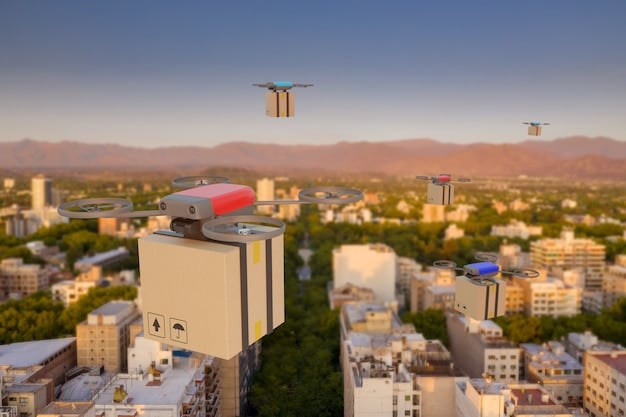Future of Online Shopping in the US: 2025 Trends

The future of online shopping in the US by 2025 will be shaped by augmented reality, enhanced personalization through AI, the seamless integration of omnichannel experiences, a growing focus on sustainable practices, and advanced delivery solutions like drone delivery.
Get ready to explore the dynamic landscape of e-commerce! The future of online shopping: trends to watch in the US in 2025 promises a revolutionary shopping experience. Are you ready to discover what’s coming next?
E-commerce Growth and Digital Transformation
The US e-commerce market is continuously growing, driven by technological advancements and evolving consumer preferences. By 2025, we can anticipate even deeper digital transformation across the retail sector.
Continued Market Expansion
The growth trajectory of e-commerce is expected to persist, with more consumers shifting their spending online. Key factors include convenience, broader product selection, and competitive pricing.
Mobile Shopping Dominance
Mobile devices will remain central to online shopping. Expect a greater emphasis on mobile-first design, optimized apps, and seamless mobile payment options.
Here are a few aspects that will be more relevant:
- Streamlined Mobile Checkout: Easier and faster mobile checkout processes will become standard.
- Enhanced Mobile User Experience: Websites and apps must offer intuitive navigation and responsive design.
- Personalized Mobile Offers: Tailored deals and recommendations based on user data will drive sales.

The Rise of Social Commerce
Social media platforms will become increasingly integrated with e-commerce, allowing users to discover and purchase products directly within their favorite apps. Consumers already spend a lot of time on social media, so expect improvements in this area.
Key trends will include:
- Buyable Pins and Posts: Direct purchasing options on platforms like Pinterest and Instagram will be common.
- Influencer Marketing: Brands will collaborate more extensively with influencers to promote products.
- Social Shopping Communities: Social platforms will foster communities around specific products or brands, driving engagement and sales.
In conclusion, the e-commerce growth will continue to influence the market. Mobile shopping and social commerce will push the growth of online businesses.
The AI-Powered Shopping Experience
Artificial Intelligence (AI) will play a pivotal role in personalizing the online shopping experience. By 2025, AI-driven solutions will transform how consumers discover, evaluate, and purchase products.
Personalized Product Recommendations
AI algorithms will analyze vast amounts of data to understand individual preferences, purchase history, and browsing behavior. This enables highly personalized product recommendations, increasing the likelihood of a sale.
AI-Driven Customer Service
Chatbots and virtual assistants powered by AI will provide instant customer support, answering questions, resolving issues, and guiding users through the purchasing process. This improve the customer experience.
AI-driven tools will be relevant in these areas:
- 24/7 Availability: AI chatbots will provide round-the-clock support, improving customer satisfaction.
- Personalized Assistance: Chatbots can offer personalized recommendations and solutions based on customer data.
- Efficient Issue Resolution: AI can quickly address common customer inquiries, freeing up human agents for more complex issues.
Visual Search and AI-Powered Product Discovery
Visual search technologies allow users to upload images of products they want to find, and AI algorithms will identify and recommend similar items. This enhances product discovery and simplifies the shopping process with the help of AI.
Expect more use of these strategies:
- Image Recognition: AI will accurately identify products in images, even if the customer doesn’t know the exact name.
- Style Matching: Algorithms will suggest similar items based on the customer’s preferred style and aesthetic.
- Augmented Reality Integration: Visual search can be combined with AR to allow customers to virtually “try on” products.
AI will revolutionize online shopping by personalizing recommendations, improving customer service, and modernizing product discovery, redefining the consumer experience in 2025.
The Rise of Augmented Reality (AR) and Virtual Reality (VR)
Augmented Reality (AR) and Virtual Reality (VR) technologies will revolutionize the way consumers interact with products online. Shoppers will experience an attractive way to visualize and engage with products.
AR-Powered Virtual Try-Ons
AR apps will allow consumers to virtually “try on” clothing, accessories, and makeup before making a purchase. This reduces uncertainty and improves the chances of a satisfying purchase.
VR Showrooms and Immersive Experiences
VR technology will enable retailers to create virtual showrooms where customers can explore products in a simulated environment. It offers brand experiences that are innovative and immersive.
More specifically, examples include:
- Interactive Product Demonstrations: VR showrooms will allow customers to interact with products and learn about their features.
- Personalized Shopping Assistants: Virtual assistants can guide customers through the showroom and offer personalized recommendations.
- Virtual Store Tours: Customers can explore virtual recreations of physical stores, browsing products as if they were there in person.

Enhanced Product Visualization
AR and VR can provide detailed product visualizations, allowing customers to zoom in, rotate, and examine items from every angle. This inspires the customers’ purchase behavior.
In general, you can expect:
- 3D Product Models: Retailers will create high-quality 3D models of their products, offering a realistic view.
- Interactive Product Views: Customers can interact with the 3D models, exploring features and options.
- Contextual Product Placement: AR allows customers to see how products will look in their own homes or environments.
The benefits of AR and VR technologies are their ability to revolutionize online shopping, improve the shopping experience, and enhance customer satisfaction in the coming years.
Sustainable and Ethical Shopping
Consumers are increasingly concerned about the environmental and social impact of their purchases. With the rise of sustainable practices in online shopping, retailers are working on meeting the rising demand for ethical products.
Transparency and Traceability
Consumers will expect greater transparency regarding the origin, production, and supply chain of products. Technologies that enable supply chain visibility will be crucial.
Eco-Friendly Packaging
Retailers will adopt sustainable packaging materials and minimize waste. This shows commitment to reducing their environmental footprint.
Elements of focus should include:
- Recyclable Materials: Using packaging materials that can be easily recycled.
- Minimal Packaging: Reducing the amount of packaging used to minimize waste.
- Compostable Options: Utilizing compostable packaging materials for certain products.
Second-Hand and Refurbished Goods
The market for second-hand and refurbished goods will continue to grow as consumers look for more affordable and sustainable options. It offers consumers the opportunity to buy sustainably by using the same product instead of buying new ones.
Expect businesses to adopt:
- Dedicated Platforms: E-commerce sites that focus on second-hand and refurbished items.
- Retailer Programs: Brands offering trade-in programs and selling refurbished products directly.
- Quality Assurance: Ensuring that second-hand and refurbished goods meet certain quality standards.
Sustainable and ethical shopping will shape the future of e-commerce, emphasizing transparency, eco-friendly practices, and the growth of the second-hand market.
The Omnichannel Experience
The integration of online and offline shopping experiences will become seamless. Omnichannel strategies will improve the customer’s shopping journey.
Click and Collect
The “click and collect” model, where customers order online and pick up their purchases in-store, will continue to be popular. This offers convenience and speed to consumers.
In-Store Technology Integration
Retailers will leverage technology to enhance the in-store shopping experience, such as digital displays, interactive kiosks, and mobile checkout options. By blending traditional stores with digital technology, businesses are able to optimize consumer experience.
More specifically, note these items:
- Digital Signage: Using digital displays to showcase products and promotions.
- Interactive Kiosks: Providing interactive product information and store navigation.
- Mobile Payment Options: Enabling customers to pay with their smartphones or mobile devices.
Unified Customer Data
Retailers will consolidate customer data from online and offline channels to create a unified view of each customer. By understanding the customer better, businesses can build more relevant deals.
Consider these data-driven strategies:
- Customer Relationship Management (CRM): Consolidating customer data in a central system.
- Personalized Marketing: Using customer data to deliver personalized offers and promotions.
- Loyalty Programs: Rewarding customers for their continued business across all channels.
The future of online shopping is one that creates a blended experience, and retailers are blending digital and physical shopping realms.
Advanced Delivery and Logistics
Faster, more efficient, and more flexible delivery options will be critical for staying competitive. Innovations in logistics are revolutionizing the delivery process in the future of online shopping.
Drone Delivery
Drone delivery services will become more widespread, especially in suburban and rural areas. Drones offer fast and efficient delivery, especially in remote areas.
Same-Day and On-Demand Delivery
Consumers will expect same-day and on-demand delivery options for a wider range of products. By providing the speed that consumers need, businesses will stay competitive.
Expect the rise of the following:
- Hyperlocal Warehousing: Establishing small-scale warehouses in urban areas to facilitate faster delivery.
- Delivery Partnerships: Collaborating with local delivery services for efficient last-mile delivery.
- Real-Time Tracking: Allowing customers to track their orders in real-time.
Delivery Robots
Autonomous delivery robots will navigate city streets. These robots are expected to offer sustainable delivery options.
Look into this:
- Sidewalk Delivery Robots: Robots designed to travel on sidewalks and deliver packages to customers’ doorsteps.
- Autonomous Vehicle Fleets: Using self-driving vehicles for longer-distance deliveries.
- Secure Package Drop-Off: Ensuring that packages are delivered safely and securely.
Developments in delivery such as: drones, same-day delivery and autonomous delivery robots, reshape consumer expectations. The future of online shopping revolves around efficient delivery solutions.
| Key Trend | Brief Description |
|---|---|
| 📱 Mobile Shopping | Mobile devices will dominate online shopping with improved UX and payment options. |
| 🤖 AI Personalization | AI will drive personalized product recommendations and enhance customer service. |
| 👓 AR/VR Shopping | AR and VR will offer virtual try-ons and immersive product experiences. |
| 🚀 Drone Delivery | Drone delivery services will become more common, especially in rural areas. |
Shopping in 2025
▼
AI will analyze your browsing and purchase history to recommend products you’re likely to buy. Chatbots will offer personalized customer service and assistance.
▼
AR enables virtual try-ons for clothing and accessories, allowing you to see how products look on you before buying, enhancing confidence in selections.
▼
Yes, sustainable shopping is on the rise. More retailers offer eco-friendly packaging and focus on transparency. Shopping ethically is in demand among consumers.
▼
Drone delivery is expected to expand, particularly in suburban and rural areas. It provides fast and efficient delivery for certain products in specific locations.
▼
Omnichannel integrates online and in-store experiences by offering options like click and collect, enhancing customer engagement. It improves convenience and customization.
Conclusion
In conclusion, the future of online shopping in the US by 2025 is set to provide advancements that will transform retail. As we approach 2025, keep an eye on the integration of AI, the use of AR/VR, and the shift toward sustainable shopping. These trends are paving the way for a different future.





